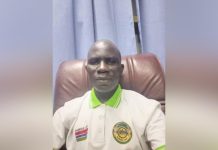
Africa-Press – Gambia. For as long as men committed to memory, it has almost always been the case that those who wielded power over others, tended to abuse the relationship by carving out certain privileges for themselves and in extreme situations, have forced others especially the weaker ones, to serfdom. Enslavement became a norm and practiced in almost all cultures. The difference was the varying degree of abuse in enforcement but enslavement was practiced around the world.
One of the most prominent and still being taught in academia is the enslavement of the African by both the Arabs and Europeans during which millions perished across the Sahara and the Atlantic Ocean. For us Africans, these two geographical features are hallowed ground for us and it will not be out of place to dedicate a month every year to pause and reflect on the abuses our forebears endured and to teach our children the sacrifices and efforts of many who toiled and risked their lives to put a stop to the barbaric trade in humans.
Historians will recollect that one Nandanko Suntu Sonko, the fifth King in the Sonko lineage of the pre-colonial state of Nuimi, attempted to stop enslavement by trying to bridge the river around Barra in 1760 as recorded below.
“.. The king ….is on a scheme of stopping some Part of the River, in order to prevent large vessels from passing his country & of course to bring the [slave] coffels down. We look upon it as chimerical and what cannot be effected…”( Joseph Debat and Robert Coulton to the Committee, James Fort, December 8, 1760, T 70/30, 358)
Nandanko Suntu Sonko in my opinion, is our first Babili Mansa, who despite the limited engineering knowledge, mobilized his people to throw boulder stones in the river to make navigation difficult and some believe that the effects of these boulders still pose problems to the ferries plying between Banjul and Barra. And so on March 25, 1807, a Royal Assent was signed banning enslavement and the trade in humans for profit across the British Empire.
In the case of the “Gambia”, (which did not exist at the time as we know it today), an attempt was made to enforce the law but because the only Crown land at the time was the fort at James Island, instructions were given to Captain Grant, an Engineer, then resident at Goree, to rebuild the fort and mount military hardware to stop slave ships from entering or leaving the River Gambia.
We need to remember too that Goree Island was British territory at this time and when you hear Colony of Senegambia, it simply means the islands of Goree and James Island. This was the first political Senegambia and lasted from 1776 to 1783.
Grant actually left Goree on March 19, 1816 with Ensign Adamson, an assistant surgeon, 50 men of the African Corps and 24 artisans. He first landed on the island of Kunu Su Joyewo (native name of the island) at Banyon Point now Half DIE or Leopold during the time of the Latvians in the 17th century. Let’s not digress.
Grant did like the island and approached Tumani Bojang Senior if he was willing to give up the island who, six weeks earlier, on February 4th 1816 had 10 men, 2 women and 8 children of his near relations captured and enslaved by men of Spanish ship called Panchita. It was a possibility in principle and Grant then left for James Island.
Whatever was happening in Kombo by 1816, it appears that a very powerful Third Force was very active outside of the native authority such that such a daring and brandish attack on the Royal House of the Bojang could be carried out. We may have to find out who this force was but it certainly disrupted order and this should be of concern to students of history to find out. No wonder, the term of agreement between Tumani Bojang Senior and the British was not very lucrative to the Bojangs.
On April 19, 1816, Colonel Thomas Brereton left Goree for James Island to see for himself the progress of rehabilitation on the island and he was disappointed. So on April 23, 1816, these two Officers met Tumani Bojang Senior and negotiated a treaty “and Grant, with the APPROVAL of Brereton, entered into a treaty with that Chief, whereby the Chief agreed to allow the British Government to occupy Banjol with liberty to erect such buildings and fortifications as might be thought expedient and further to surrender all his right and title to the island in exchange for an annual payment of 103 bars of iron to himself, his wife, and his principal retainers “.
But as we will see later, the purchase of St Mary’s Island did not immediately stop enslavement and as a matter of fact, enslavement continued in Bathurst after it being taken over by the British. Few examples may be necessary to drive the message home. Slavery was abolished on paper in Gambia but not in practice and the Colonial Government looked the other way
Though slavery was abolished, the colonial government allowed skilled slave labor from Goree who would return after their assignments. Lieutenant Governor George Rendall in particular ignored this illegal business to flourish on the grounds that Bathurst lacked labor.
Reverend Robert Maxwell Macbriar, a linguist employed by the Fula mission made it his work to expose labor abuses. One Pierre Salla who later became a Weslyan preacher was only liberated when the Mission raised money to buy his freedom.
In another incident a lady who converted to Christianity in Bathurst was forced to chop fire wood in the bush in without pay. When she refused, her husband was taken to the bush and beaten.
When they complained to the Magistrate, he said he had no powers and only the Governor could do something. When they approached the Governor, his response was that the bush was outside of his jurisdiction as if the island of Bathurst was not British territory. (MacBriar page 213).
In another incident, the children of the concubine of the Governor were taken back to Goree because the children’s mother was an enslaved woman and her master demanded the children as his property. So the Governor knew that his concubine was an enslaved woman right from the start. There could never be a better example to proof that enslavement was only forbidden on paper but not in practice.
The father of children was asked to pay the children’s worth or lose them. Directives from London, because of a complaint lodge there as the local administration was unwilling to take action, changed the course of events and a frigate was sent to Goree ready to fire her cannons to enforce the order but the French handed over the children and united with their father without incident. We too had our own Gonzales theatre much earlier.
In fact, the Signoras from Goree had an intricate network of escorts placed among the rich merchants and along the corridors of power, and made fortunes out of these escorts to the knowledge of the powers that were.
In the case of another enslaved African in the person of John Cupidon, he “was of respectable parentage, but had been taken captive and reduced to the condition of a domestic slave”(Sketches of a Missionary’s Travels by Macbrair page 202). Further evidence of the story of John Cupidon can be found in another text: The History of the Wesleyan Methodist Missionary Society at page 129 as follows:
“Among those who had, through the faithful ministry of John Morgan, received the freedom with which Christ makes men free was a young Jalouf (Wolof), who had received the name “Coupidon” from the French at Goree”.
The colonial officials first developed hatred for the mission to the extent of instigating burning down the residence of John Cupidon, a Liberated African turned missionary simply because some European found the location of his house strategic and wanted his land which was legally assigned to him.
Some Liberated Africans on the island of McCarthy were served rum, and overseers appointed with whips to ensure that they destroyed Cupidon’s house. It was black on black while the Commandant of the island quietly left his residence to create the impression that he was not around even though Macbrair did inform him of a planned destruction of the residence of Mr. Cupidon.
Yes, they may have escaped the whips on the slave ships to the Americas but had their own from the overseers. This would have been in contravention of the conditions of asylum granted to them in Bathurst.
Not only did the Lieutenant Governor refused to issue a warrant but also the Colonial Secretary who was also the chief judge of the colony. This was a blatant disregard of the very policy that made them who they were; employees in the service of the Crown to protect and defend the rights of these Liberated Africans. No wonder the scheme failed with many lives lost.
To be continued.
Source: The Gambia | Standard News From The Gambia
For More News And Analysis About Gambia Follow Africa-Press





